Cinerama Arrives | Read more at in70mm.com The 70mm Newsletter |
| Written by: William R Latady, Director of Installation for Cinerama, Inc. Printed in Theatre Catalog 1953-54, and prepared for in70mm.com by Anders M. Olsson, Lund, Sweden | Date: 02.11.2012 |
 THE METHOD OF TAKING AND PROJECTING the
film and sound to create the full Cinerama effect of realistic participation
is graphically illustrated in the schematic diagram, as seen below. THE METHOD OF TAKING AND PROJECTING the
film and sound to create the full Cinerama effect of realistic participation
is graphically illustrated in the schematic diagram, as seen below.Click the image to see an enlargement BRIEF: The opening of Cinerama in New York may well be considered as one of the history making events in the motion picture business . . . This new and exciting form of film entertainment was met with enthusiasm by the public and industry alike . . . The triple projector system with a seven track stereophonic sound system created installation difficulties which required original and unique solutions . . . Since there was no previous experience to draw upon . . . brand new and untried tactics had to be used. The 1950-51 edition of THEATRE CATALOG carried one of the earliest stories about the then experimental system . . . In keeping with its policy of reporting the progress made on new developments . . . we are presenting this article written by the man who was in charge of the first theatre installation of Cinerama . . . In it will be found an account of how it was installed . . . the equipment used . . . and some predictions about future applications of Cinerama. Cinerama is the bombshell that started the explosion of many fragments in the minds of optical engineers of the motion picture industry in general. Although Cinerama had been under development for 14 years and had been available for demonstration to the public for perhaps three years, it was not until September 30, 1952 that a Cinerama performance was finally presented to the public at the Broadway Theatre in New York. This so-called "impractical system" so impressed the first audiences that the repercussion of their applause was heard around the world. True, the system is more complicated than the standard motion picture process in use for the past 25 years, but this has been necessary in the initial stages, because standardized equipment was utilized and adapted to create the illusion that Cinerama does so well. This illusion is the feeling of being present on the spot where the picture was taken. It gives the audience he feeling that they are participating in the action which they are viewing on the screen. The triple projector system necessary to encompass a field of 146 degrees and the seven track stereophonic sound system are the secrets to the magic which you view when attending a performance. Present optical design does not permit such a wide field in a single system with one lens. However, further developments will simplify this process without sacrifice to the quality of the show. | More in 70mm reading: in70mm.com's Cinerama page The Birth of an Idea Internet link: |
Development | |
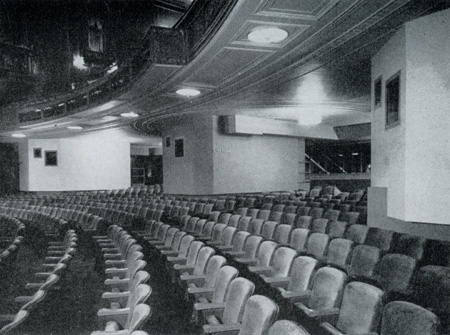 THE BROADWAY AFTER INSTALLATION of
Cinerama booths. Note the larger projection and observation ports for
operator. The long, horizontal structure at the top of the center booth
is the special duct for exhausting and cooling the booths. Some
orchestra seats had to be eliminated. THE BROADWAY AFTER INSTALLATION of
Cinerama booths. Note the larger projection and observation ports for
operator. The long, horizontal structure at the top of the center booth
is the special duct for exhausting and cooling the booths. Some
orchestra seats had to be eliminated.To start with the development of the Cinerama process, we must go back 14 years to the time when Fred Waller first conceived the idea of the creation of an illusion of three dimensions by the use of peripheral vision. From the first idea to the final Cinerama concept many systems were developed and tested, the most startling of which was an 11 lens camera and projector that formed an image on the inside of a partial sphere. This, of course, was terribly effective, but not conducive to exhibition in any of the existing theatres, or to a large audience. That system was modified into a seven-eyed monster, which after further research and experimentation was finally simplified into the present three-eyed wonder. Following this to a logical conclusion, we would expect that the next advance would be the use of a single lens system. This, of course, with our present knowledge of optics, is a Jules Vernion projection of thoughts into the future. Waller had created an environmental feeling of participation in the action by the viewers from the point of view of sight; the next thing was to create the same illusion by means of sound, to complete the effect. Paralleling Waller's development of an optical system was Hazard E. Reeves' work in the perfection of the use of magnetic tape for sound reproduction. Upon the standard 35mm tape he placed seven separate tracks, such that the response was far greater than anything that had ever been recorded in an optical process. By specially placing the microphones used in picking up an orchestra and by placing speakers in the same position, a realism was created which startled even the musicians themselves. So true was this sound that it was difficult, if not impossible, to tell when the orchestra was playing and when the sound was being played back through the sound system, if one could not see the musicians. With Waller's development and Reeves' creation married and acting as one, the new illusion was complete. With this special baby for entertaining the world at large now developed and ready for use, the next problem was to place it in a theatre so that it could be seen. Many long hours were spent in the discussion of what would be shown to the public to best introduce this new brain-child. Discussions followed this line: giving a great musical, or a dramatic play — perhaps a wild Western, or a thriller-chiller that would startle the audience. Those who discussed these points all had their favorites, but it was Lowell Thomas who finally won out in his persuasion to make Cinerama the hero. He felt that the audience should appreciate what this new medium could give to them, and not like or dislike the particular dramatic sequence that was being shown. I am sure that the present presentation of "THIS IS CINERAMA" bears tribute to Thomas's fine judgment of what the public wants to see. | |
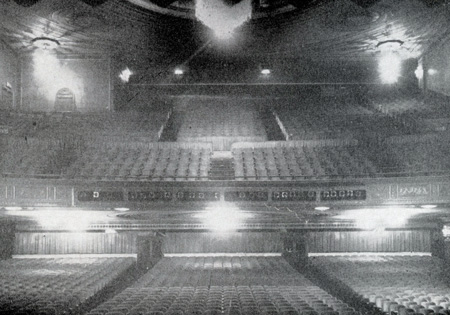 THIS VIEW OF THE BROADWAY prior to the
Cinerama installation shows the original appearance of the balcony and
orchestra before structural changes were made and orchestra seats
eliminated. THIS VIEW OF THE BROADWAY prior to the
Cinerama installation shows the original appearance of the balcony and
orchestra before structural changes were made and orchestra seats
eliminated.Great chances were taken with the Cinerama camera as the production crew paddled down the canals of Venice or strapped it into the nose of a B-25 and flew through the canyons of the Western parks. Many days and nights were spent in cutting this film on improvised moviolas and rewind equipment that was not built for the purpose of handling six perforation frames and 8000 foot reels. However, with the many obstacles that were found at each turn of the road, “This Is Cinerama” was made ready to show. The next step was to create a show-place where our new system and new production could be exhibited. Again, after much deliberation, the Broadway Theatre on Broadway in New York City was chosen. We soon discovered that the Cinerama system was new in all its aspects, for the Broadway Theatre was designed for stage shows, and adaptable to the standard type of picture. Not so for Cinerama! The proscenium was too narrow, the balcony was too low, the floor was not strong enough, and the boxes were in the way. Despite these disadvantages we put Cinerama into the theatre, and presented a spectacle that was larger and greater than anything previously seen or heard by a New York theatre audience. The editor of the New York Times rushed out of the theatre after the final curtain, knocking down a doorman in order to get a front-page story into the Times the following morning. Skeptics, critics and executives of the movie world could not believe that Waller's development in a tennis court in Oyster Bay could ever be like this. The fundamentally simple ideas for the multiplicity of one single film and track had been woven into such a clever device as to give an unbelievable result. | |
Installation | |
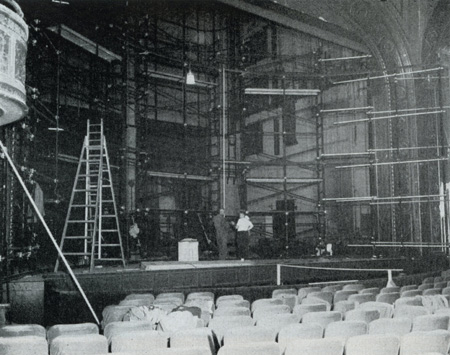 THE TREMENDOUS CINERAMA SCREEN
necessitated an installation technique which had been unheard of in
theatre operation. A network of scaffolding was required to handle the
detailed and amazing job. THE TREMENDOUS CINERAMA SCREEN
necessitated an installation technique which had been unheard of in
theatre operation. A network of scaffolding was required to handle the
detailed and amazing job.The installation of the Cinerama equipment into the Broadway Theatre entailed a great many interesting, if not revolutionary, ideas to theatre people on all sides. Whoever heard of putting a booth in the middle of the orchestra floor? Cinerama put three of them in the orchestra! This had to be done in order to project the three pictures onto a large, curved screen to form one continuous image. The booths were made as close as possible to a standard New York-approved booth. All of the safety devices normally used were provided, such as automatic safety shutters, fire extinguishers, and a complete and separate ventilation system, which exhausted the air from each booth once every three minutes directly to the outside air. Fresh air was brought from the outside directly to each booth for the comfort of the operators. Each booth contained a single projector using magazines for 8000 feet of film, which would run our non-standard film (speed of 146.25 feet per minute) for about 50 minutes. Also in this booth a control panel was installed for the operation of the projector and the coordination of that one projector with the rest of the system. This panel also has a servo amplifier, a power amplifier for the auditorium speakers, and an intercom so that the operator can at all times be in communication with the man running the show. Only one operator is present in a booth for each show, since each booth holds only one projector. The high cost of the specially developed equipment and the space on the orchestra floor dictates that the show must be run in this manner. | |
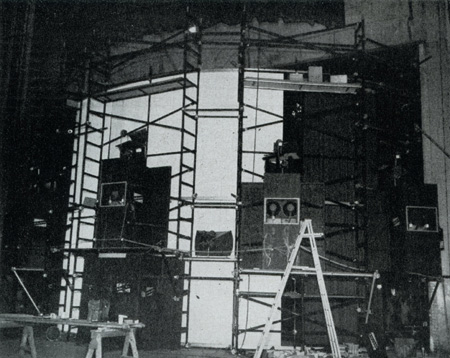 THIS BACKSTAGE VIEW gives an insight
into the mechanism of the stereophonic sound system. Note the contrast
with the standard theatre sound system in the center below the Cinerama
network. THIS BACKSTAGE VIEW gives an insight
into the mechanism of the stereophonic sound system. Note the contrast
with the standard theatre sound system in the center below the Cinerama
network.Many miles of wire were put into the theatre in order to supply the power, the intercommunications, and the audio connections to each of these booths. Three phase and single phase 110V, 220V and DC were run into each booth. 24V DC for control systems was also connected from booth to booth. All of this had to be approved by the authorities in the city, who were slightly awed by the whole thing. Just what was this Cinerama, and what would it do? Was it dangerous to have in a theatre, and after all, was it worth while putting it in? Everyone was questioning and sceptical; certainly about it staying more than two weeks. | |
Equipment | |
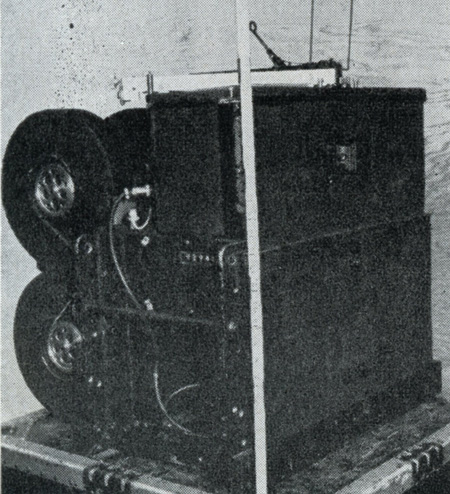 THIS IS THE FIRST three-lens camera
with which the film "This Is Cinerama" was taken. THIS IS THE FIRST three-lens camera
with which the film "This Is Cinerama" was taken.To get back to the installation itself, besides the three booths, a special curved screen and curtain must be installed. This screen filled the complete proscenium arch and protruded on either side approximately eight feet out into the orchestra. The two proscenium boxes had to come out and so a wrecking crew knocked them down. This screen had to be supported, and since it was out beyond the proscenium, the gridiron was of no use beyond this point. A special portable aluminum scaffold had been designed which could quickly be installed in a standard manner in a standard theatre. Alas, the Broadway was no standard theatre for Cinerama. And so, it was adapted to fit around the configuration of the proscenium. A great curved track had been specially built and then rebuilt to fit into the niches of this theatre. Vertically moving masking curtains, both top and bottom, were also installed. All of these curtains, masks and scaffolding were new to the theatrical world. The house carpenter, who was over 70, had rigged a lot of peculiar things in his days, but he never saw anything quite like this. This monstrous screen covered everything behind stage and went out into the audience, enabling them to observe a show that was twice as large as any legitimate show they had ever seen before. This brought up an all important question. What about the lowering of the asbestos curtain? How could this be done with the screen in the way? The answer, of course, was that it could not be lowered. A special dispensation had to be granted to us by the Fire Department in order to tie off and make inoperative this curtain; and this consent was given to us on condition that the backstage area would be completely cleared of inflammable material, and that it would not be used. Also, no persons were to be there except the house electricians. In retrospect, this is simple to say — but the granting of this special ruling was a long and complicated process entailing many discussions with the authorities. Five groups of speakers were placed on the large scaffold backstage, oriented such that the projected sound covered the theatre evenly. Each of these speakers was fed by a separate track on the sound film, which was on a fourth projector placed in the standard projection booth upstairs. This sound projector was the master control for the three slave picture projectors in the synchronization system. Once the system was up to speed, synchronization was automatically controlled by the three phase motors driving each of the four projectors. In addition, however, a special motor and differential unit were placed in each of the picture projectors to add or subtract frames while the show was in motion. This was done in case the projectionists misframed or the film was incorrectly cut. This system is unique in itself, being the first of its type where a correction in synchronization can be made after the starter switch has been thrown. | |
Control Board | |
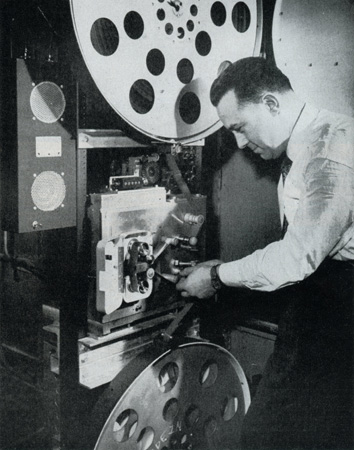 THIS SEPARATE SOUND TRACK is the master
control unit for the synchro system and is responsible for the
stereophonic sound system used in Cinerama. Note the eight thousand foot
reels used for an uninterrupted fifty minute show. Audience reaction
attests to the realistic effects which are created. THIS SEPARATE SOUND TRACK is the master
control unit for the synchro system and is responsible for the
stereophonic sound system used in Cinerama. Note the eight thousand foot
reels used for an uninterrupted fifty minute show. Audience reaction
attests to the realistic effects which are created.The nerve center of this system is at a control board which was placed in this installation in the orchestra pit. This panel is manned by the engineer in charge of the operation of the show. He starts and stops all of the projectors with a throw of a switch after the individual in each booth has thrown his system from "local" to "remote." He can add or subtract frames during the running of a show. He can lighten or brighten each individual panel during the course of the presentation of the picture. He is also the intermediary through whom all messages go. The intercoms do not go from booth to booth, but go from each booth to the control console, so that all messages come first to the nerve center for registration. Signal lights keep him constantly posted on the operation of all this equipment. He can further control the volume of the sound in the theatre on all speakers, either separately or together, and he can "patch" in the sound on the different groups of the eight auditorium speakers. In our Cinerama show this console operator is the bandleader who directs the musicians, at their machines to better the performance. As if three booths, a special console house, and a fourth projector in the standard booth were not enough, we further provided additional space, where from time to time all four prints could be united in one sync machine to be checked. There was no room in the cramped quarters of the booth, and even smaller manager's office of the Broadway, so a wardrobe in the basement was rebuilt with new linoleum floor and shiny white walls to be used for film inspection and replacement of worn parts. No one, including Eastman-Kodak, had ever run film continuously at 146 feet per minute. No one was able to predict how long it would last under such treatment. This room provided a basis of operation for research on this subject. In the early stages all of the film was rewound here, as we believed very special care must be taken of it. We later found that by the insistence of proven methods it could be rewound in the booths as is normally the case. | |
Operation | |
 THE COMPLETED CINERAMA SCREEN at the
Broadway is made up of more than one thousand louvres which appear to be
a solid sheet. Note the size compared to the width of the stage. THE COMPLETED CINERAMA SCREEN at the
Broadway is made up of more than one thousand louvres which appear to be
a solid sheet. Note the size compared to the width of the stage.Finally, one week before opening night, installation of the Cinerama system was completed. Projectors had been aligned so that magnification of all three were equal, and the three films so positioned that they formed one image. All of the wires were "buzzed" and the speakers placed in the best position for the optimum effect. Everything was in readiness as far as the system was concerned, but there was one element which had not been taken care of to date. The engineers who had developed the system had been so busy putting it in, aligning it, and operating it, that they had forgotten that they were not the ones who would be running the show. Naturally, as in all cases, the New York projectionists would take over and keep the ball rolling as they had been doing for so many years. We almost forgot that this was not standard equipment and that no one, including fellows who had worked at the business for 30 years, had ever run the Cinerama projectors. We immediately wrote specifications for a training course and put this into effect. Operation of the Cinerama equipment required far more attention by the operators than previously necessary, since there was a continuous problem of framing the pictures and adjusting carbons at the onset. The coordination necessary for five people to work in five different locales required the skill of a basketball team. No longer were the fellows working as individuals, but as a group, who only when they worked together could they make a successful showing. | |
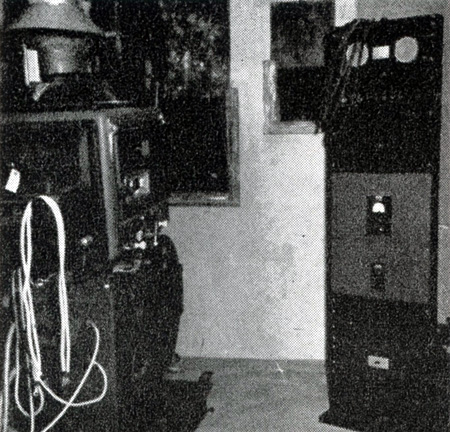 THE CONTROL RACK is shown at the right
in this view of the Cinerama projection booth. THE CONTROL RACK is shown at the right
in this view of the Cinerama projection booth.Many problems arose and were solved during this week concerning the running of the show — specifically the handling of the film, which is on reels 30 inches in diameter weighing 40 pounds. September 30 arrived too soon for those who were working desperately to make sure that everything was perfect. An audience of curious and adventuresome people arrived that night to witness the first performance. The reception that was received startled those who had produced the show as much as anyone else. We felt that this was a revolutionary process, that there was nothing like it; but then, we believed in it. The people who saw the show that night had seen it for the first time, and they acclaimed it far more than we dared to. The next morning the New York Times placed the performance several rungs above the advent of sound and substantiated our claims for the new and revolutionary process. The lines at the ticket office went around the block. Cinerama has been a sell-out in New York since that day. | |
Conclusions | |
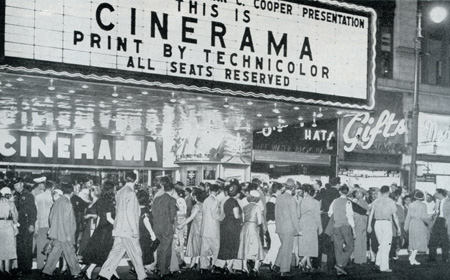 Our policy at Cinerama has been to try to
bring back the feeling of the theatre to a motion picture audience in
the manner of exhibition. We want to make a performance first-class in
every way including the treatment given to individuals who come to the
theatre to be entertained. Only "hard" tickets are sold, guaranteeing
everyone a reserved seat. Because so much entertainment is provided
today in the home, we think it is important to create an atmosphere of
showmanship when people go out for an evening's entertainment. We
believe that Cinerama will always be a premium type show to be exhibited
only in the large cities of the world. We expect that this will be
limited to approximately 100 cities strategically placed, so that the
greatest number of people will be able to see this new type of
entertainment. Our policy at Cinerama has been to try to
bring back the feeling of the theatre to a motion picture audience in
the manner of exhibition. We want to make a performance first-class in
every way including the treatment given to individuals who come to the
theatre to be entertained. Only "hard" tickets are sold, guaranteeing
everyone a reserved seat. Because so much entertainment is provided
today in the home, we think it is important to create an atmosphere of
showmanship when people go out for an evening's entertainment. We
believe that Cinerama will always be a premium type show to be exhibited
only in the large cities of the world. We expect that this will be
limited to approximately 100 cities strategically placed, so that the
greatest number of people will be able to see this new type of
entertainment.There are now many processes rivalling Cinerama. Some are of similar nature in concept and some are gimmicks to suck in the passing curiosity seeker. None to date have succeeded in creating the true Cinerama feeling which physically moves the audience to follow the action on the screen. We feel that even with this tremendous moving power the final value of our entertainment is the show. Great shows have been created and more are still to come. With Cinerama the good can be great and the great far greater! | |
| Go: back - top - back issues - news index Updated 22-01-25 |
